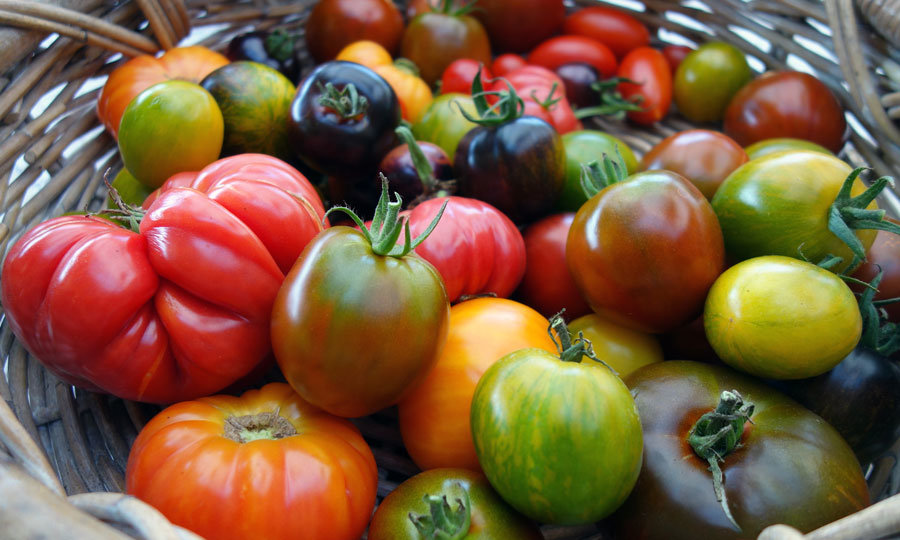
Tomatoes. For some, the memory of the first bite of a garden-grown vine-ripened tomato ranks right up there with a first kiss. Or the birth of a child. For others, great tomatoes have always been a part of life. That’s certainly the case for Dee Hendrix of Lakebay. But that in no way diminishes her passion for them.
Hendrix grew up in Eastern Washington where her family had a small farm that provided much of what they ate. She grew up eating her mother’s heirloom tomatoes. Hendrix met her husband in 1981 and they bounced around for a few years, she said, but they visited the Key Peninsula, fell in love with the area and moved here in 1989. They lived just across from the Lakebay Marina until 2004 when they bought their current place. She named it My Mother’s Garden in honor of her mom.
“It’s a great place for a garden,” she said. “It gets good sun, and the owner ran sheep and a cow there before we moved in.” She developed a local reputation for her tomatoes when she sold them through the local farmers market and Fresh Food Revolution. Those days are gone, but she still loves her heirlooms and has plenty of valuable advice.
Hendrix has some favorite varieties — heirloom tomatoes that have been around for 50 years or more — from the 20 or so she has grown. The Mortgage Lifter, so named because it helped Radiator Charlie pay off his mortgage, is one. She also loves Aunt Ruby’s German Green, Kellogg’s Breakfast and Martino’s Roma. Jerry McCourt, an inveterate gardener, is a Stupice and Brandywine fan. And Hendrix admits that a good hybrid like Sungold or Sweet Million can hold its own in the flavor department.
With our short growing season, it is important to pay attention to “days to maturity,” which is more of a guide than an absolute. For tomatoes it generally means the time it takes from setting out a seedling until the first tomato ripens and it can vary from 65 to 90 days. A shorter time may assure a plentiful crop before fall ends the season, but weather conditions also impact the maturity date. A year that is sunnier than usual makes a difference. Janet Dowling, who has been growing tomatoes for 40 years, said the May 1980 eruption of Mount St. Helen led to the worst tomato season in her memory. “The sun was unable to break through the clouds of volcanic dust for the entire summer,” she said.
It is too late to start your own from seed this year. To get a plant that will mature and produce seed you should start in mid-February, Hendrix said. But she had advice for next season. She uses cell pack trays, and if she knows the seed is good, she will place just one seed in a cell. If it’s old or she has any doubts, she’ll plant three or four and then thin them when they germinate. Once they have three sets of true leaves, she transfers them to a 4-inch pot, planting them deep, since the stem will develop roots if it is buried. “A 4-inch pot should be big enough for the plant to grow until it’s ready for the garden,” she said.
Seedlings are available through garden stores, at some farmers markets, and from local gardeners who have extras if they are willing to part with them. Look for plants that are not leggy and are medium to dark green. Plant them deep.
“There is no point in planting in the garden until the soil is at least 50 degrees — the plant will survive if you plant it sooner and it isn’t freezing, but it won’t grow,” Hendrix said. She places a black ground cover over the soil to warm it, cutting holes for the plants. McCourt uses old tires as planters and says they also work well to warm the earth. Catherine Kosel, who cans at least 80 quarts of tomatoes each year, uses a big hoop tent over the plants to keep them warm and to keep the inevitable fall rains from ruining a late crop.
Hendrix said that a key to a good crop is to prune them. Every other branch, she said, is a sucker branch that does not produce flowers. Prune those and there will be more sun for the developing tomatoes. She also thins the plants by pulling some leaves in mid-August.
Some tomato varieties are determinate — they are bushes, only grow to a certain height, and the fruit ripens at the same time. Others are indeterminate — they are vines and will keep growing. “Flowers in August won’t get ripe,” Hendrix said. “So cut the plant off at the top, give it a haircut, and the existing tomatoes will get the message and grow ripe and sweet.”
Once you’ve eaten a vine-ripened tomato, it is hard to go back. Commercial varieties were bred for a consistent red color, improved shelf life and uniform size. It turns out that when you select for those traits you eliminate genes that make the tomato sweeter and more flavorful. Hendrix, for one, never eats a store-bought tomato.
UNDERWRITTEN BY THE FUND FOR NONPROFIT NEWS (NEWSMATCH) AT THE MIAMI FOUNDATION, THE ANGEL GUILD, ADVERTISERS, DONORS AND PEOPLE WHO SUPPORT INDEPENDENT, NONPROFIT LOCAL NEWS